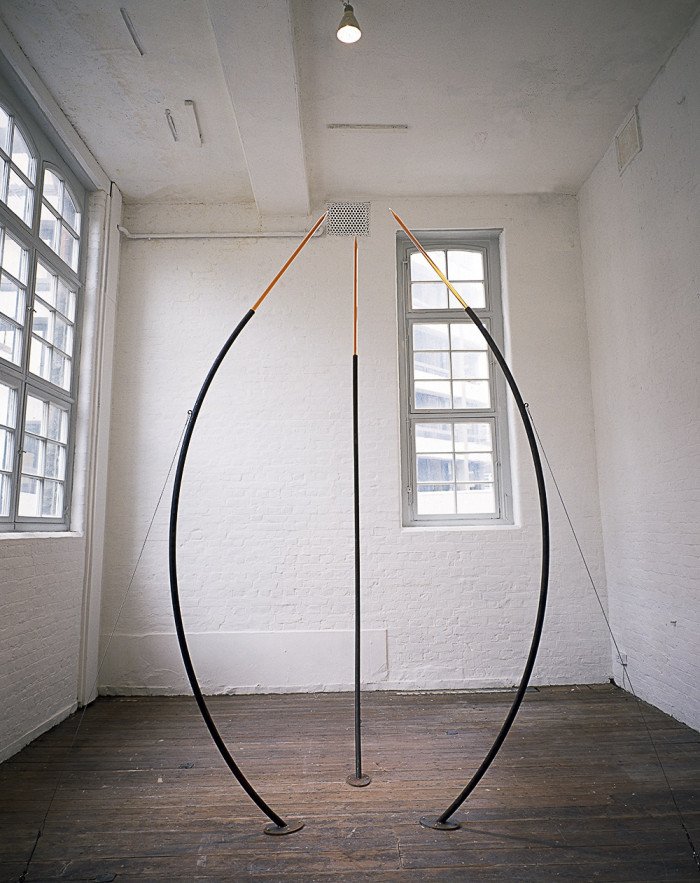Hamad Butt
Hamad Butt (1962-1994) was born in Lahore in 1962 and came to Britain with his family when he was 2. He grew up in Ilford, Essex and developed twin interests in the arts and sciences.
“Butt’s journals from that time reveal his emotional turmoil as he sought to reconcile his sexuality and desire to pursue art with his religion and his family’s expectations of a career in science.”
Hamad Butt, c. 1990
In the 1980s he studied at Central St. Martin’s and then Goldsmith’s between 1987-1990, working alongside many of the Young British Artists (YBAs), part of a group of ‘hazardist’ artists.
“Hamad could in that period have been seen as almost not relevant to those who expected things to be spelled out in a very clear-cut way,” says Butt’s former tutor Sarat Maharaj. “His subtlety and the deliberate opacities and obscurities of his work must have baffled quite a lot of people.”
His work ‘Transmission’ (on display at Tate Britain, summer 2024), was originally shown at his degree show in June 1990. It consisted of glass books, uv lamps, a video installation of a triffid and a wall hung cabinet containing fly pupae and paper soaked in sugar solution on which were written enigmatic statements. The flies hatched, ate the paper, reproduced and died in what Butt described as; “an endless cycle of information being literally eaten, digested and passed on”.
The next month Damian Hirst exhibited his own fly installation ‘A thousand years’.
‘Created at the height of the Aids epidemic in Europe and the US, Transmission evokes multiple terrors.’
Elizabeth Fullerton
In 1993, Hamad Butt was commissioned by the John Hansard Gallery to make Familiars, an installation including three halogens from the periodical table (chlorine, iodine and bromine). These halogens were presented in highly precarious situations within glass containers - a giant version of a Newton’s Cradle, a Venus flytrap and a Jacob’s ladder. Familiars was included in Tate Gallery’s Rites of Passage exhibition in 1995, and subsequently entered their permanent collection in 2014.
The term familiars is leaden with meaning. One definition is that of an interdimensional being, a tragic reference to his own life, someone living with HIV/AIDS - a foot in both this life and the next.
In 1996, in collaboration with Iniva, the gallery published a book, which included Hamad’s writings on the innovative aesthetic and scientific ideas that informed Familiars.
Before his AIDS-related death in 1994, aged 32, Butt completed and showed four key sculptural installations and left behind writings, drawings, paintings, and plans for new installations. In 2014, a letter signed by many of the most notable curators, artists, critics and writers was sent to Tate supporting the acquisition of several of Butt’s works.
“Hamad’s work opened up an entirely original avenue of aesthetic research that has yet to be explored, and to which end the proposed Tate acquisition of Familiars will provide a uniquely valuable resource”
Goldsmith’s also awards the annual ‘Hamad Butt Award’, supported by his family, which is awarded to a student of exceptional promise at the end of their second year. Hamad’s brother Jamal is a wonderful custodian to his brother’s legacy. The website is a valuable resource.
Butt is an important artist and individual and I’m saddened I’ve only recently discovered his work. Thankfully, a retrospective of his installations, drawings and paintings opens at IMMA, Dublin on December 5, 2024; ‘Hamad Butt, Apprehensions’. The show will travel to The Whitechapel Art Gallery, London in June 2025.
The title of the exhibition is taken from Butt’s essay of the same name which was first published in the ‘posthumous artist’s book’ Familiars, edited by Stephen Foster. For Butt, the word ‘apprehensions’ carries several meanings simultaneously, including being gripped with fear, the scene of capture, and grasping or groping for understanding, suggesting a series of suspended moments that, like Butt’s structures, project us into a space of fear and precarity.
The exhibition is curated by Dominic Johnson, Professor of Performance and Visual Culture at Queen Mary University of London, and co-curated by Gilane Tawadros, Director of the Whitechapel Gallery, London and Seán Kissane, Curator: Exhibitions, IMMA. The exhibition is organised in cooperation with Jamal Butt.
IMMA have published a catalogue to accompany the exhibition. Visit their website to buy a copy.







